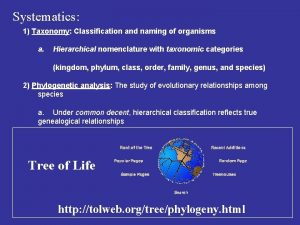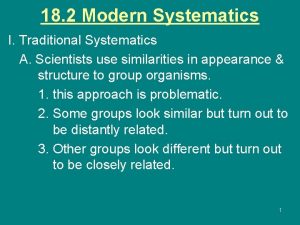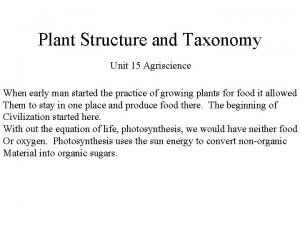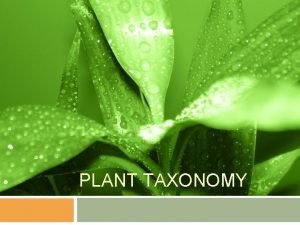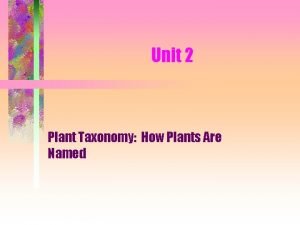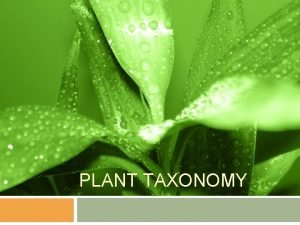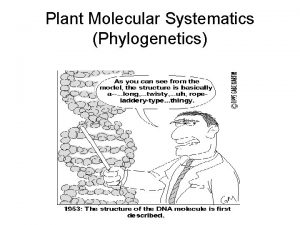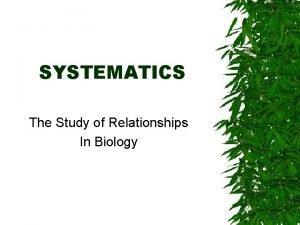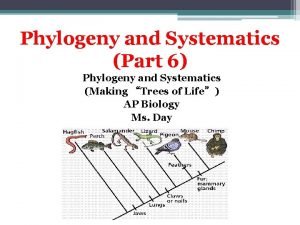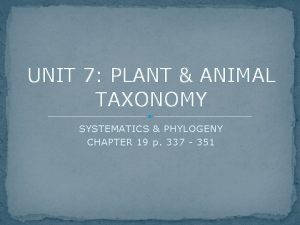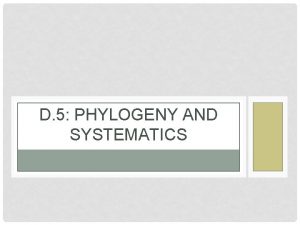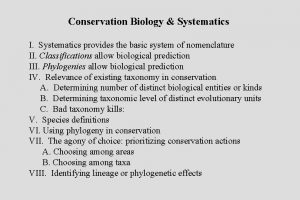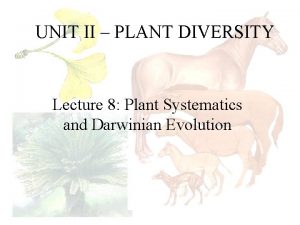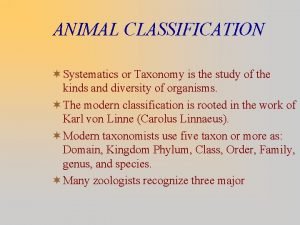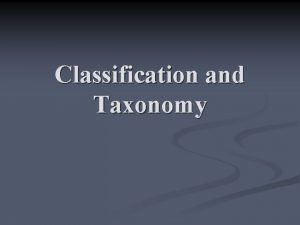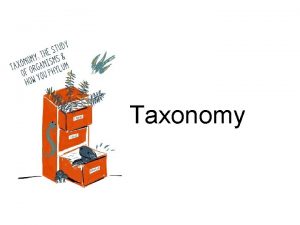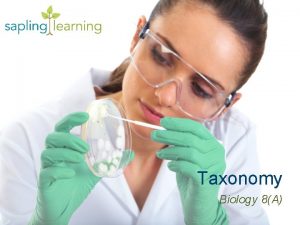Plant Taxonomy Definitions Taxonomy systematics the study and















































- Slides: 47

Plant Taxonomy

Definitions • Taxonomy (systematics) - the study and description of the variation of organisms, the investigation of the causes and consequences of this variation, and the manipulation of the data obtained to produce a system of classification • Classification (as process) - the production of a logical system of categories, each containing any number of organisms, which allows easier reference to its components, the kinds of organisms • Classification (as object) - is that logical system itself

Definitions cont’d • Identification - naming of an organism by reference to an already existing classification system • Taxon - any taxonomic grouping - phylum, class, family, genus, etc. • Description - statement of the characteristics of a taxon • Characters that contribute to a taxonomic description are known as taxonomic or systematic characters

Definitions cont’d • flora (lower case) - plant life of a given area • Flora (upper case) is a book or other work describing the flora of a given area

Need for Classification • need for some system of classification is absolute, because it is only by first naming organisms and then grouping them in recognizable categories that we can begin to sort out and understand the vast array of diversity which exists • Our current estimate is that there about 280, 000 total plant species; with 263, 000 species of higher vascular plants that have been described and named - ferns, gymnosperms, flowering plants - about 2, 000 new species of flowering plant are described every year

Southern magnolia – Magnolia grandifolia

Rank Ending Kingdom Example Plantae Division (Phylum) - phyta Class - opsida Magnoliophyta Or Anthophyta Magnoliopsida Order - ales Magnolioales Family - aceae Magnolioaceae Genus Magnolia Species grandifolia

Hierarchies of plant taxonomy – from Stace

Taxonomic Systems • Predictivity - Ideally our systems of classification should allow us to place similar species of plants together in the same category


Two Types of Classification Schemes • Artificial classification schemes - these systems allow one to quickly categorize a particular organism, usually so that it can be quickly found in a book or a herbarium • Natural classification scheme - organize together related groups of plants and have a high degree of predictive power

Artificial Classification Scheme

Artificial Classification Scheme Red Trillium White Trillium

Natural Classification Scheme – For Seed Plants

Ancient Classifications

Oaks - Fagaceae

Maples - Aceraceae

Pennisetum – a grass - Poaceae

Carex – sedge meadow - Cyperaceae

Juncus – rushes - Juncacaea

Vegetables from Brassica oleracea Brassicaceae

Theophrastus 370 -285 BCE

Dioscorides – 1 st Century AD

Page from 15 th century Arabic edition of Dioscorides herbal

Leonhart Fuchs - 1542

Fuchs’s History of Plants - 1542

Gerard’s Herbal 1597

Gaspar Bauhin - 1623

1623 – first use of binomial names

Carolus Linneaus

Systema Naturae – first published 1735

Classification After Darwin

Evolutionary Classification Schemes • Botanists have tried to develop classification systems that are natural and also show evolutionary relationships - this has been surprisingly hard to do • In developing classification systems, we attempt to group plants which share advanced or derived characteristics - presumably these characters have only arisen once or at most a few times - it is not always easy to tell what is an advanced character though

Natural Classification Scheme – For Seed Plants

Basics of Characters • A taxonomic character is any expressed attribute of an organism that can be evaluated and that has two or more discontinuous states or conditions - for example the number of petals on a flower - can be in 3's, 4's or 5's - thus distinct states and they are discontinuous • The taxonomic value of a characteristic is increased if the biological significance of the characteristic has been determined

Goat Dandelion - Asteraceae

Buttercup - Ranunculaceae

Morphology • Plants are highly plastic in their growth forms - how tall they grow, their shape will vary depending upon environment and growing conditions • However reproductive structures tend not to differ in form from plant to plant of the same species - they may differ in number, but form is conservative - flowers, cones tend to be similar within all members of a species - thus much plant classification and identification is based upon reproductive structures


Umbel – flower head in Apiaceae

Brassicaceae – The mustards

Oak acorns - Fagaceae

Birch catkin Betulaceae

Other important characteristics • Internal anatomy – mostly important for studies of evolutionary relationships – not often used in identification guides • Physiology – mostly for classifying parasites and saprobes (plants that decompose dead matter) • Chemistry – can be important because some groups have distinct chemical compounds – the mints are aromatic with distinct odor • DNA –there is interest in developing easy methods to differentiate species based on short sequences of DNA – much work done with the DNA for Ru. Bis. CO – an important enzyme in photosynthesis • Ecology and geography can also be important – some plant species or families are restricted to particular environments or geographic areas

Mint


Cactus
 Systematics vs taxonomy
Systematics vs taxonomy Taxonomy vs systematics
Taxonomy vs systematics Traditional systematics
Traditional systematics Systematics deals with
Systematics deals with Section 2 modern classification
Section 2 modern classification Kendall and marzano's new taxonomy
Kendall and marzano's new taxonomy Unit 15 plant structures and taxonomy
Unit 15 plant structures and taxonomy Tronsmo plant pathology and plant diseases download
Tronsmo plant pathology and plant diseases download Tronsmo plant pathology and plant diseases download
Tronsmo plant pathology and plant diseases download Albugo eye
Albugo eye Plant classes taxonomy
Plant classes taxonomy Unit 2 plant taxonomy how plants are named
Unit 2 plant taxonomy how plants are named Learning objectives of types of plants
Learning objectives of types of plants Plant and machinery valuation
Plant and machinery valuation Taxonomy study of
Taxonomy study of Sem vi
Sem vi Taichum
Taichum Plant introduction in plant breeding
Plant introduction in plant breeding Hát kết hợp bộ gõ cơ thể
Hát kết hợp bộ gõ cơ thể Lp html
Lp html Bổ thể
Bổ thể Tỉ lệ cơ thể trẻ em
Tỉ lệ cơ thể trẻ em Voi kéo gỗ như thế nào
Voi kéo gỗ như thế nào Tư thế worm breton
Tư thế worm breton Hát lên người ơi
Hát lên người ơi Các môn thể thao bắt đầu bằng từ đua
Các môn thể thao bắt đầu bằng từ đua Thế nào là hệ số cao nhất
Thế nào là hệ số cao nhất Các châu lục và đại dương trên thế giới
Các châu lục và đại dương trên thế giới Công thức tính độ biến thiên đông lượng
Công thức tính độ biến thiên đông lượng Trời xanh đây là của chúng ta thể thơ
Trời xanh đây là của chúng ta thể thơ Mật thư anh em như thể tay chân
Mật thư anh em như thể tay chân Phép trừ bù
Phép trừ bù độ dài liên kết
độ dài liên kết Các châu lục và đại dương trên thế giới
Các châu lục và đại dương trên thế giới Thơ thất ngôn tứ tuyệt đường luật
Thơ thất ngôn tứ tuyệt đường luật Quá trình desamine hóa có thể tạo ra
Quá trình desamine hóa có thể tạo ra Một số thể thơ truyền thống
Một số thể thơ truyền thống Cái miệng nó xinh thế chỉ nói điều hay thôi
Cái miệng nó xinh thế chỉ nói điều hay thôi Vẽ hình chiếu vuông góc của vật thể sau
Vẽ hình chiếu vuông góc của vật thể sau Biện pháp chống mỏi cơ
Biện pháp chống mỏi cơ đặc điểm cơ thể của người tối cổ
đặc điểm cơ thể của người tối cổ V cc
V cc Vẽ hình chiếu đứng bằng cạnh của vật thể
Vẽ hình chiếu đứng bằng cạnh của vật thể Fecboak
Fecboak Thẻ vin
Thẻ vin đại từ thay thế
đại từ thay thế điện thế nghỉ
điện thế nghỉ Tư thế ngồi viết
Tư thế ngồi viết

